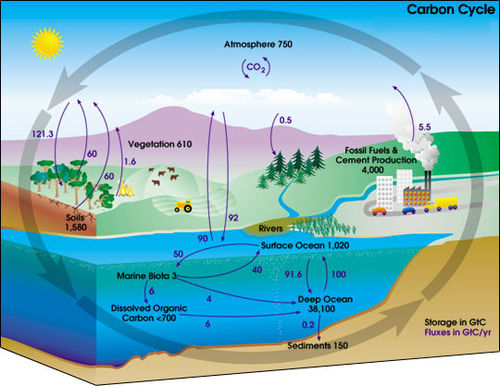The carbon cycle is a very, very important part of all natural life on earth but not many know about this process and its effects. In a simplified explanation it can be compared to the water cycle since it moves through the land and atmosphere. On the earth's crust most carbon is found either in fossil fuels or in living creatures (carbon is an elemental building block in all living things). In our atmosphere it is a gas that traps our heat from the sun, acting as a sort of climate buffer. And in the ocean it is stored in the water as well as the sedimentary rocks on the ocean floor. Now as for the question of how the carbon moves to and from each of these locations we have to look at the processes.
So let's start with carbon on the earth's crust. Carbon starts with living things. When they die the carbon is either released back into the atmosphere or preserved to later become a fossil fuel (after a few million years that is). Even when living things are alive they release carbon, for example when animals poop there is CO2 in their feces that (sort of in a way) "evaporates" back into the air; and we as humans release CO2 when we exhale. Carbon is also absorbed into bodies of water where it dissolves or is used by organisms in the ecosystem. (This eventually builds up sediments when the organisms die and their remains breakdown to the floor of the ocean, lake, etc. The product is limestone which holds carbonate and can later re-release carbon dioxide into the atmosphere). When CO2 is in the air it either rises to our atmosphere or is used by plants. Plants use CO2 as a reactant in the process of photosynthesis to create energy and, and as a byproduct, releases oxygen into the air. But when CO2 cycles back into our atmosphere it creates something called the greenhouse effect (also know as greenhouse gases). This is what traps the sun's heat reflecting heat back onto land and maintains a constant temperature range that is compatible for sustaining life.
Over the last few years the carbon cycle in our atmosphere has been thrown out of balance. There has been a build up of carbon dioxide causing an extreme form of the green house effect. This layer of carbon has trapped more and more heat which is reflected back onto earth causing global warming. The unbalance has been caused by an overuse and release of carbon dioxide into the atmosphere. Plants cannot keep up with respiration to convert the carbon and therefore partially causing the carbon build up. The build up is also attributed to us as humans burning and using billions and billions of tons of fossil fuels and carbon each year. In other words we have slowly been polluting our atmosphere and setting the natural balance off kilter.
The carbon cycle plays a very essential role in nature and can have many affects in all aspects of life. The balance is quite delicate and should be taken care of so it only takes its natural course. Carbon is part of each living organism and is used in one way or another for all life, even inorganic substances. It has a simple course and can be broken down and understood very easily.
Links:
The links are some sources I used and found helpful in explaining the carbon cycle. They have more in depth detail of carbon/carbon cycle and how it moves and plays a major role in the environment. This also includes some websites with short facts about the carbon cycle and its movement.
- http://www.elmhurst.edu/~chm/vchembook/306carbon.html
- http://www.esrl.noaa.gov/research/themes/carbon/
- http://www.columbia.edu/~vjd1/carbon.htm
- http://carboncycle.aos.wisc.edu/
- http://www.sciencelearn.org.nz/Contexts/The-Ocean-in-Action/Sci-Media/Animations-and-Interactives/Carbon-cycle
Videos:
These are some helpful videos to break down the carbon cycle as well as explain the significance of carbon in the environment.
Photos:


No comments:
Post a Comment